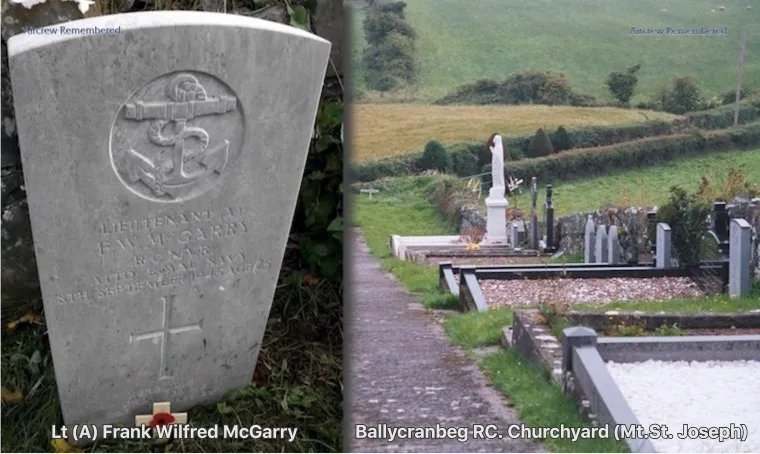
McGarry, F W (Lieutenant)
unknown 1945-September-08

Birth Date: unkown date
Born:
Parents:
Spouse:
Home:
Enlistment:
Enlistment Date: unkown date
Service
RCNVR
Unit
768 Sqn- Squadron (FAA)
Base
Ballyhalbert
Rank
Lieutenant
Position
Service Numbers

Corsair serial: JT357

Chance Vought F4U Corsair, RN.
Designed and initially manufactured by Chance Vought, the Corsair was operated as a carrier-based aircraft, and entered service in large numbers with the USN and RN in late 1944 and early 1945. Additional production contracts were given to Goodyear, whose Corsairs were designated FG, and Brewster, whose Corsairs were designated F3A.
From the first prototype delivery to the U.S. Navy in 1940, to final delivery in 1953 to the French, 12,571 F4U Corsairs were manufactured in 16 separate models. Its 1942"“1953 production run was the longest of any American piston-engined fighter.
In November 1943, the Royal Navy received its first batch of 95 Vought F4U-1s, which were given the designation of "Corsair I". The first squadrons were assembled and trained on the American East Coast and then shipped across the Atlantic. The Royal Navy put the Corsair into carrier operations immediately. They found its landing characteristics dangerous, suffering a number of fatal crashes, but considered the Corsair to be the best option they had.
The Royal Navy developed a number of modifications to the Corsair that made carrier landings more practical. Among these were a bulged canopy (similar to the Malcolm Hood), raising the pilot's seat 7 in (180 mm), and wiring shut the cowl flaps across the top of the engine compartment, diverting oil and hydraulic fluid spray around the sides of the fuselage.
The Royal Navy initially received 95 "birdcage" F4U-1s from Vought which were designated Corsair Mk. I in Fleet Air Arm service. Next from Vought came 510 "blown-canopy" F4U-1A/-1Ds, which were designated Corsair Mk. II (the final 150 equivalent to the F4U-1D, but not separately designated in British use). 430 Brewster Corsairs (334 F3A-1 and 96 F3A-1D), more than half of Brewster's total production, were delivered to Britain as the Corsair Mk. III. 857 Goodyear Corsairs (400 FG-1/-1A and 457 FG-1D) were delivered and designated Corsair Mk. IV. The Mk. IIs and Mk. IVs were the only versions to be used in combat.
The Royal Navy cleared the F4U for carrier operations well before the USN and showed that the Corsair Mk. II could be operated with reasonable success even from escort carriers. It was not without problems; one was excessive wear of the arrester wires, due both to the weight of the Corsair and the understandable tendency of the pilots to stay well above the stalling speed. A total of 2,012 Corsairs were supplied to the United Kingdom.
Fleet Air Arm (FAA) units were created and equipped in the United States, at Quonset Poiint, Rhode Island, or Brunswick, Maine, and then shipped to war theatres aboard escort carriers. The first FAA Corsair unit was 1830 NAS, created on the first of June 1943, and soon operating from HMS Illustrious. At the end of the war, 18 FAA squadrons were operating the Corsair. British Corsairs served both in Europe and in the Pacific. The first, and also most important, European operations were the series of attacks (Operation Tungsten) in April, July, and August 1944 on the German battleship Tirpitz, for which Corsairs from HMS Victorious and HMS Formidable provided fighter cover. It appears the Corsairs did not encounter aerial opposition on these raids.
From April 1944, Corsairs from the British Pacific Fleet took part in a several major air raids in South East Asia beginning with Operation Cockpit, an attack on Japanese targets at Sabang island, in the Dutch East Indies.
In July and August 1945, Corsair naval squadrons 1834, 1836, 1841, and 1842 took part in a series of strikes on the Japanese mainland, near Tokyo. These squadrons operated from HMS Victorious and HMS Formidable. On 9 August 1945, days before the end of the war, Corsairs from HMS Formidable attacked Shiogama harbour on the northeast coast of Japan. Royal Canadian Navy Volunteer Reserve pilot, Lieutenant Robert Hampton Gray, of 1841 Squadron was hit by flak but pressed home his attack on a Japanese destroyer, sinking it with a 1,000 lb (450 kg) bomb but crashing into the sea. He was posthumously awarded Canada's last Victoria Cross, becoming the second fighter pilot of the war to earn a Victoria Cross as well as the final Canadian casualty of the Second World War. Harold Skaarup web page